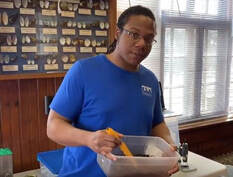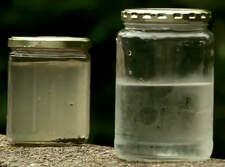Life science Lesson Plans
NEW LESSON PLAN IDEAS ARE WELCOME. SEE BELOW FOR INSTRUCTIONS ON SUBMITTING.
ALL LESSON PLANS MAY BE DOWNLOADED AND USED FOR FREE!!!
ALL LESSON PLANS MAY BE DOWNLOADED AND USED FOR FREE!!!

Do Aquariums Have Complete Food Chains?
by the Education Staff of the Belle Isle Aquarium
Amy Emmert, Education Director for the Belle Isle Conservancy, invites students in to the Belle Isle Aquarium to explore the driving question "Do aquariums in the Belle Isle Aquarium have complete food chains?" In addition to showing the beautiful tanks and fish of the Aquarium, students work through a "food chain" worksheet to identify energy sources, producers, primary consumers, secondary consumers, and tertiary consumers. Created during the COVID-19 epidemic for fourth and fifth grade Science.
by the Education Staff of the Belle Isle Aquarium
Amy Emmert, Education Director for the Belle Isle Conservancy, invites students in to the Belle Isle Aquarium to explore the driving question "Do aquariums in the Belle Isle Aquarium have complete food chains?" In addition to showing the beautiful tanks and fish of the Aquarium, students work through a "food chain" worksheet to identify energy sources, producers, primary consumers, secondary consumers, and tertiary consumers. Created during the COVID-19 epidemic for fourth and fifth grade Science.

Welcome to the Belle Isle Aquarium Ecosystem Laboratory
by the Education Staff of the Belle Isle Aquarium
This lesson continues the virtual field trip to the Belle Isle Aquarium with a visit to the Belle Isle Aquarium's Ecology Laboratory to see decomposers in action, make measurements of water quality, and learn about invasive species. Fifth Grade Science.
by the Education Staff of the Belle Isle Aquarium
This lesson continues the virtual field trip to the Belle Isle Aquarium with a visit to the Belle Isle Aquarium's Ecology Laboratory to see decomposers in action, make measurements of water quality, and learn about invasive species. Fifth Grade Science.

What is an Ecosystem?
by Sonya Brown
Students observe an aquarium--either a drawing of one or a classroom aquarium--and discuss the question "What is an ecosystem?" A hands-on activity is making diagrams of food chains observed in aquariums. Students might discuss the aquariums they saw at the Belle Isle Aquarium on a field trip. Fifth Grade Science.
by Sonya Brown
Students observe an aquarium--either a drawing of one or a classroom aquarium--and discuss the question "What is an ecosystem?" A hands-on activity is making diagrams of food chains observed in aquariums. Students might discuss the aquariums they saw at the Belle Isle Aquarium on a field trip. Fifth Grade Science.

Exploring Water Garden Ecosystems
By Maria Siciliano
This lesson gives students the opportunity to create and monitor their own mini-water garden, complete with plants and a fish! Students will learn how the plant cleans the fish’s environment, showing that all organisms play a role in maintaining a healthy ecosystem. This lesson assumes that the students have already visited the Belle Isle Aquarium. Grade 5 Science.
By Maria Siciliano
This lesson gives students the opportunity to create and monitor their own mini-water garden, complete with plants and a fish! Students will learn how the plant cleans the fish’s environment, showing that all organisms play a role in maintaining a healthy ecosystem. This lesson assumes that the students have already visited the Belle Isle Aquarium. Grade 5 Science.

Creating stories for science or engineering videos
by Jeffrey Ram
Students learn the components of a good story, analyze these parts in a short video, then work on creating video stories of their own. Story topics in the lesson are about environmental problems of invasive species and plastics. Cross-curricular, between language arts and science at fifth to eighth grade level.
by Jeffrey Ram
Students learn the components of a good story, analyze these parts in a short video, then work on creating video stories of their own. Story topics in the lesson are about environmental problems of invasive species and plastics. Cross-curricular, between language arts and science at fifth to eighth grade level.

Food Chains and Food Webs
by Robin Crawford, Gardner Elementary School, Detroit
Students study the relationships between producers and consumers in food chains. Using the 'Mystery Science" resource "creature cards, students use game playing to illustrate the relationships. Target grade and subject: 5th grade Life Science.
by Robin Crawford, Gardner Elementary School, Detroit
Students study the relationships between producers and consumers in food chains. Using the 'Mystery Science" resource "creature cards, students use game playing to illustrate the relationships. Target grade and subject: 5th grade Life Science.

It's Time for a Water Check-Up--You be the Doctor
by Connie Atkisson, Thirkell Elementary-Middle School , Detroit conniecoolest(at)aol.com
Students consider what makes rivers and streams safe for the organisms in them and how that relates to the water they drink and use for cleaning and cooking. Students learn about water quality tests, apply these tests in their class to "real world" water samples, and then discuss the results and meaning of their experiments. Target grade and subject: 5th grade General Science.
by Connie Atkisson, Thirkell Elementary-Middle School , Detroit conniecoolest(at)aol.com
Students consider what makes rivers and streams safe for the organisms in them and how that relates to the water they drink and use for cleaning and cooking. Students learn about water quality tests, apply these tests in their class to "real world" water samples, and then discuss the results and meaning of their experiments. Target grade and subject: 5th grade General Science.

New lesson plan ideas are welcome and will be uploaded as they are received and approved.
Instructions for submitting lesson plans for:
About invasive species,
About science and science careers
For information about submitting new lesson plans, please contact jchadde(at)mtu.edu
Lesson plan ideas from other web sites:
From Pennsylvania Sea Grant: 10 lesson plans about interactions of invasive species, biodiversity, and climate change
Creation of the above page of educational resources was funded in part by the Michigan Invasive Species Grant Program through the Departments of Natural Resources, Environmental Quality, and Agricultural and Rural Development.
This material is also based upon work supported by the National Science Foundation under Grant No. 1614187.
Any opinions, findings, and conclusions or recommendations expressed in this material are those of the authors and do not necessarily reflect the views of the National Science Foundation.
Instructions for submitting lesson plans for:
About invasive species,
About science and science careers
For information about submitting new lesson plans, please contact jchadde(at)mtu.edu
Lesson plan ideas from other web sites:
From Pennsylvania Sea Grant: 10 lesson plans about interactions of invasive species, biodiversity, and climate change
Creation of the above page of educational resources was funded in part by the Michigan Invasive Species Grant Program through the Departments of Natural Resources, Environmental Quality, and Agricultural and Rural Development.
This material is also based upon work supported by the National Science Foundation under Grant No. 1614187.
Any opinions, findings, and conclusions or recommendations expressed in this material are those of the authors and do not necessarily reflect the views of the National Science Foundation.